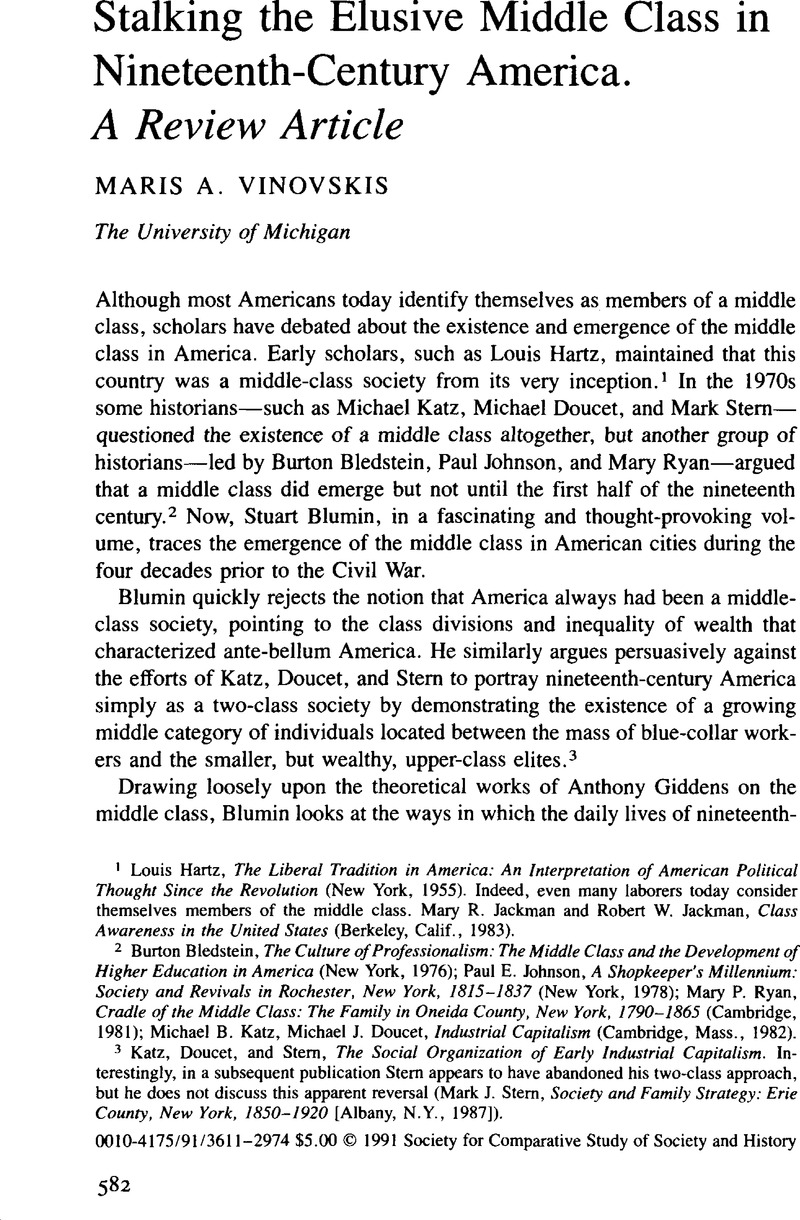Article contents
Stalking the Elusive Middle Class in Nineteenth-Century America
Published online by Cambridge University Press: 03 June 2009
Abstract

- Type
- Searching for the Middle Class
- Information
- Copyright
- Copyright © Society for the Comparative Study of Society and History 1991
References
1 Hartz, Louis, The Liberal Tradition in America: An Interpretation of American Political Thought Since the Revolution (New York, 1955).Google Scholar Indeed, even many laborers today consider themselves members of the middle class. Jackman, Mary R. and Jackman, Robert W., Class Awareness in the United States (Berkeley, Calif., 1983).Google Scholar
2 Bledstein, Burton, The Culture of Professionalism: The Middle Class and the Development of Higher Education in America (New York, 1976);Google ScholarJohnson, Paul E., A Shopkeeper's Millennium: Society and Revivals in Rochester, New York, 1815–1837 (New York, 1978);Google ScholarRyan, Mary P., Cradle of the Middle Class: The Family in Oneida County, New York, 1790–1865 (Cambridge, 1981);Google ScholarKatz, Michael B., Doucet, Michael J., Industrial Capitalism (Cambridge, Mass., 1982).Google Scholar
3 Katz, Doucet, and Stern, The Social Organization of Early Industrial Capitalism. Interestingly, in a subsequent publication Stern appears to have abandoned his two-class approach, but he does not discuss this apparent reversal (Stern, Mark J., Society and Family Strategy: Erie County, New York, 1850–1920 [Albany, N.Y., 1987]Google Scholar).
4 Giddens, Anthony, The Class Structure of the Advanced Societies (New York, 1975).Google Scholar For more recent and comprehensive discussions of his theories, see his The Constitution of Society: Outline of the Theory of Structuration (Berkeley, Calif., 1984);Google Scholar as well as Cohen, Ira J., Structuration Theory: Anthony Giddens and the Constitution of Social Life (New York, 1989).CrossRefGoogle Scholar For a useful overview and introduction to the theoretical controversies over the nature of the middle class, see Abercrombie, Nicholas and Urry, John, Capital, Labour & the Middle Classes (London, 1983).Google Scholar
5 Wilentz, Sean, Chants Democratic: New York City and the Rise of the American Working Class, 1788–1850 (New York, 1984).Google Scholar
6 Dawley, Alan, Class and Community: The Industrial Revolution in Lynn (Cambridge, Mass., 1976);Google ScholarFaler, Paul G., Mechanics and Manufacturers in the Early Industrial Revolution: Lynn, Massachusetts, 1780–1860 (Albany, N.Y., 1981).Google Scholar For a perceptive critique of those two studies, see Lenger, Friedrich, “Class, Culture and Class Consciousness in Ante-Bellum Lynn: A Critique of Alan Dawley and Paul Faler,” Social History, 6 (10 1981), 317–32.CrossRefGoogle Scholar
7 Hirsch, Susan E., Roots of the American Working Class: Industrialization of Crafts in Newark, 1800–1860 (Philadelphia, 1978).Google Scholar
8 Ryan, Cradle of the Middle Class. Although Ryan raises important issues in regard to middle-class family strategies, her statistical analysis is inadequate for the task of establishing the existence and nature of such practices.
9 Thernstrom, Stephan, Poverty and Progress: Social Mobility in a Nineteenth-Century City (Cambridge, Mass., 1964).Google Scholar
10 Vinovskis, Maris A., “Have We Underestimated the Extent of Ante-Bellum High School Attendance?” History of Education Quarterly, 28 (Winter 1988), 551–67.CrossRefGoogle Scholar
11 Faler, Mechanics and Manufacturers in the Early Industrial Revolution; Hirsch, Roots of the American Working Class.
- 2
- Cited by




